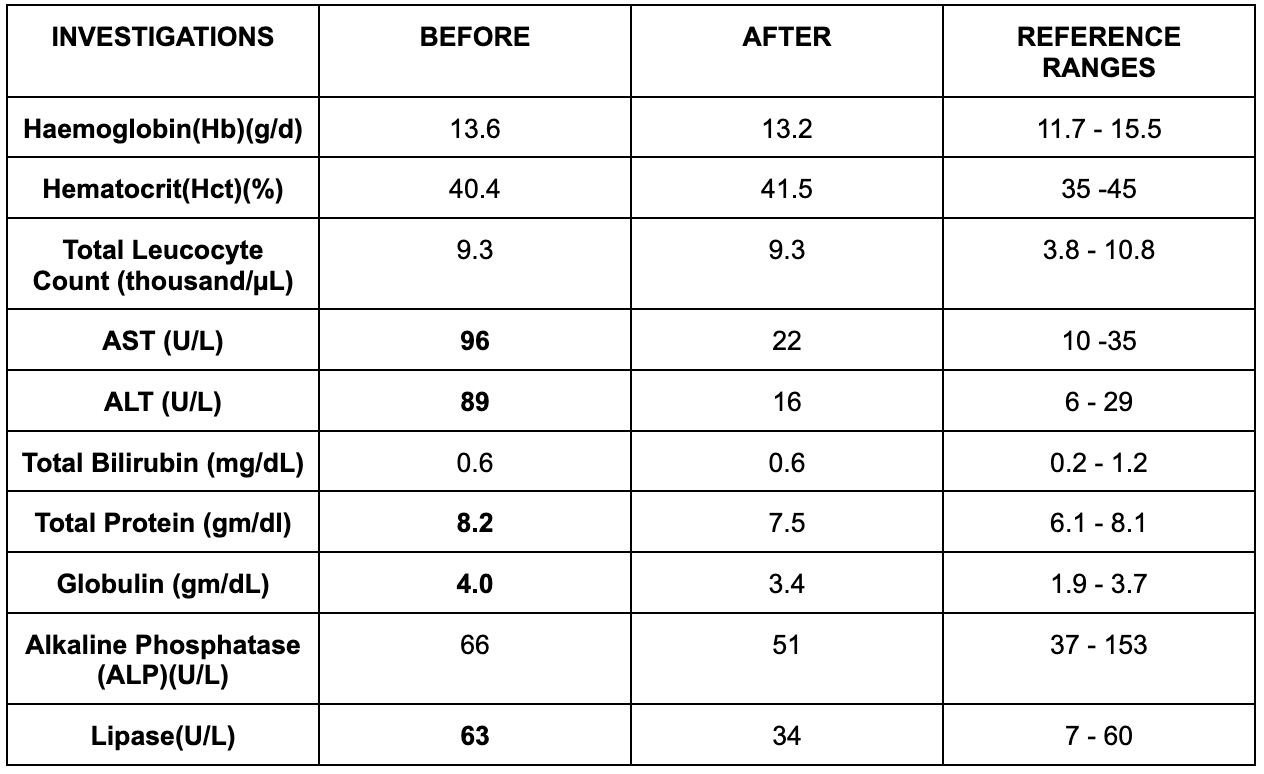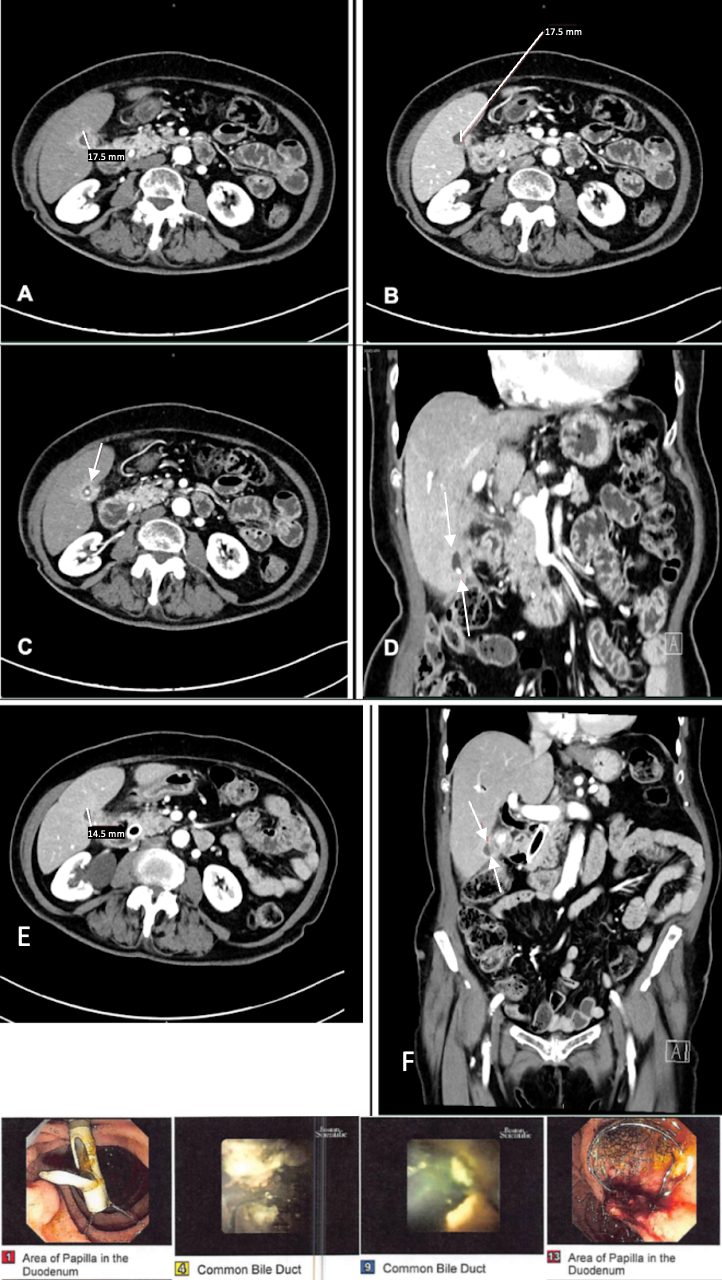Tuesday Poster Session
Category: Biliary/Pancreas
P4475 - Fully Covered Self-Expanding Metal Stent Improves Refractory Biliary Complications Including Perihepatic Abscess Following Partial Cholecystectomy
Tuesday, October 28, 2025
10:30 AM - 4:00 PM PDT
Location: Exhibit Hall

Dhruvi A. Shah, MD (she/her/hers)
University of Maryland Medical Center
Baltimore, MD
Presenting Author(s)
Dhruvi A. Shah, MD1, Kaumudi Somnay, MD2, Prakhar Bajpai, MBBS3, Rawan Elwalid. Jad, MBBS4
1University of Maryland Medical Center, Mahwah, NJ; 2NewYork-Presbyterian/Queens, Flushing, NY; 3Jawaharlal Nehru Medical College, Belagavi, India, Belagavi, Karnataka, India; 4International Medical University, New York, NY
Introduction: Partial cholecystectomy is often performed in cases of severe acute cholecystitis when a complete cholecystectomy is not feasible, making it a necessary, life-saving choice. However, it carries long-term risks such as retained stones, biliary strictures, and intra or peri-hepatic abscesses. We present a case of recurrent biliary obstruction, strictures, and intrahepatic abscesses post-PC, successfully managed with endoscopic retrograde cholangiopancreatography (ERCP)-guided fully covered self-expanding metal stent (FCSEMS) placement.
Case Description/
Methods: An 80-year-old female with a history of PC (2022) presented in 2024 with 7 weeks of right upper quadrant pain, fever, and weight loss. Imaging revealed gallstones in the gallbladder remnant, common bile duct (CBD) stones, a perihepatic abscess (1.7 cm) adjacent to the gallbladder fossa, and a distal CBD stricture. She initially underwent plastic stent placement, which was replaced multiple times for recurrent biliary obstruction, stricture progression, and eventually, stent migration. Despite multiple ERCPs with sphincterotomy and stone extraction performed from January to August 2024 using plastic stents, her symptoms persisted throughout.
ERCP with cholangioscopy in October 2024 with biopsy revealed a fibrotic stricture and a migrated stent proximal to CBD stricture which was successfully removed. A 10 mm × 6 cm FCSEMS was deployed, resulting in immediate stone and sludge-filled biliary drainage. One week follow-up of the patient revealed marked symptomatic improvement and follow-up CT in 6 months showed a reduction in abscess size (1.7 cm to 1.4 cm), stone clearance, and normalization of liver enzymes (ALT/AST: 16/22 U/L). The patient remained asymptomatic at the 6-month follow-up.
Discussion: ERCP with cholangioscopy allows precise visualization of biliary strictures and is useful in assessing post-(PC) CBD complications. In our case, residual cystic duct remnants or gallstones likely triggered chronic inflammation, leading to fibrosis, stricture formation, and a perihepatic abscess. Post-PC complications were effectively managed with FCSEMS. Their anti-migration design, radial force, and long-term patency support stricture remodeling and sustained biliary drainage, reducing infection risk and aiding abscess resolution. FCSEMS provides a minimally invasive, definitive option for managing refractory biliary complications, especially in elderly or high-risk surgical patients. Early intervention may enhance outcomes and prevent recurrence.

Figure: Figure A-D: Radioscopic CT-Scan Images taken in March 2024; Showing a 17.5 mm perihepatic multilocular collection with internal calcifications & retained gallstones.
Figure E-F: Radiographic (CT-Scan) Images taken in October 2024 showing the successful passage of retained perihepatic calcification after FCSEMS Placement with a reduction in the size of the perihepatic collection to 14.5 mm.
Figure G: October 2024; ERCP Image 1: Videoscopic view showing obstructed plastic stent; Image 4: CBD stricture with stones; Image 9: Migrated plastic biliary stent in real-time; Image 13: shows the proper placement of FCSEMS into the CBD and protruding out from the duodenal papilla to facilitate the passage of gallstones & biliary sludge.

Figure: TABLE 1: Hematological Investigations at the Time of Initial Presentation and after FCSEMS Placement
Disclosures:
Dhruvi Shah indicated no relevant financial relationships.
Kaumudi Somnay indicated no relevant financial relationships.
Prakhar Bajpai indicated no relevant financial relationships.
Rawan Jad indicated no relevant financial relationships.
Dhruvi A. Shah, MD1, Kaumudi Somnay, MD2, Prakhar Bajpai, MBBS3, Rawan Elwalid. Jad, MBBS4. P4475 - Fully Covered Self-Expanding Metal Stent Improves Refractory Biliary Complications Including Perihepatic Abscess Following Partial Cholecystectomy, ACG 2025 Annual Scientific Meeting Abstracts. Phoenix, AZ: American College of Gastroenterology.
1University of Maryland Medical Center, Mahwah, NJ; 2NewYork-Presbyterian/Queens, Flushing, NY; 3Jawaharlal Nehru Medical College, Belagavi, India, Belagavi, Karnataka, India; 4International Medical University, New York, NY
Introduction: Partial cholecystectomy is often performed in cases of severe acute cholecystitis when a complete cholecystectomy is not feasible, making it a necessary, life-saving choice. However, it carries long-term risks such as retained stones, biliary strictures, and intra or peri-hepatic abscesses. We present a case of recurrent biliary obstruction, strictures, and intrahepatic abscesses post-PC, successfully managed with endoscopic retrograde cholangiopancreatography (ERCP)-guided fully covered self-expanding metal stent (FCSEMS) placement.
Case Description/
Methods: An 80-year-old female with a history of PC (2022) presented in 2024 with 7 weeks of right upper quadrant pain, fever, and weight loss. Imaging revealed gallstones in the gallbladder remnant, common bile duct (CBD) stones, a perihepatic abscess (1.7 cm) adjacent to the gallbladder fossa, and a distal CBD stricture. She initially underwent plastic stent placement, which was replaced multiple times for recurrent biliary obstruction, stricture progression, and eventually, stent migration. Despite multiple ERCPs with sphincterotomy and stone extraction performed from January to August 2024 using plastic stents, her symptoms persisted throughout.
ERCP with cholangioscopy in October 2024 with biopsy revealed a fibrotic stricture and a migrated stent proximal to CBD stricture which was successfully removed. A 10 mm × 6 cm FCSEMS was deployed, resulting in immediate stone and sludge-filled biliary drainage. One week follow-up of the patient revealed marked symptomatic improvement and follow-up CT in 6 months showed a reduction in abscess size (1.7 cm to 1.4 cm), stone clearance, and normalization of liver enzymes (ALT/AST: 16/22 U/L). The patient remained asymptomatic at the 6-month follow-up.
Discussion: ERCP with cholangioscopy allows precise visualization of biliary strictures and is useful in assessing post-(PC) CBD complications. In our case, residual cystic duct remnants or gallstones likely triggered chronic inflammation, leading to fibrosis, stricture formation, and a perihepatic abscess. Post-PC complications were effectively managed with FCSEMS. Their anti-migration design, radial force, and long-term patency support stricture remodeling and sustained biliary drainage, reducing infection risk and aiding abscess resolution. FCSEMS provides a minimally invasive, definitive option for managing refractory biliary complications, especially in elderly or high-risk surgical patients. Early intervention may enhance outcomes and prevent recurrence.

Figure: Figure A-D: Radioscopic CT-Scan Images taken in March 2024; Showing a 17.5 mm perihepatic multilocular collection with internal calcifications & retained gallstones.
Figure E-F: Radiographic (CT-Scan) Images taken in October 2024 showing the successful passage of retained perihepatic calcification after FCSEMS Placement with a reduction in the size of the perihepatic collection to 14.5 mm.
Figure G: October 2024; ERCP Image 1: Videoscopic view showing obstructed plastic stent; Image 4: CBD stricture with stones; Image 9: Migrated plastic biliary stent in real-time; Image 13: shows the proper placement of FCSEMS into the CBD and protruding out from the duodenal papilla to facilitate the passage of gallstones & biliary sludge.

Figure: TABLE 1: Hematological Investigations at the Time of Initial Presentation and after FCSEMS Placement
Disclosures:
Dhruvi Shah indicated no relevant financial relationships.
Kaumudi Somnay indicated no relevant financial relationships.
Prakhar Bajpai indicated no relevant financial relationships.
Rawan Jad indicated no relevant financial relationships.
Dhruvi A. Shah, MD1, Kaumudi Somnay, MD2, Prakhar Bajpai, MBBS3, Rawan Elwalid. Jad, MBBS4. P4475 - Fully Covered Self-Expanding Metal Stent Improves Refractory Biliary Complications Including Perihepatic Abscess Following Partial Cholecystectomy, ACG 2025 Annual Scientific Meeting Abstracts. Phoenix, AZ: American College of Gastroenterology.

